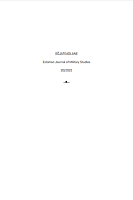RUSSIAN CAPABILITIES IN CONVENTIONAL HIGH INTENSITY WARFARE. LESSONS FROM THE 2022 INVASION OF UKRAINE
RUSSIAN CAPABILITIES IN CONVENTIONAL HIGH INTENSITY WARFARE. LESSONS FROM THE 2022 INVASION OF UKRAINE
Author(s): Anton PaierSubject(s): International relations/trade, Security and defense, Military policy, Peace and Conflict Studies, Russian Aggression against Ukraine
Published by: Kaitseväe Akadeemia (KVA)
Keywords: Russian military reforms, command philosophy; military proficiency and sociocultural heritage; Russian invasion of Ukraine;
Summary/Abstract: The Russian Federation is today one of the world’s major military powers. The most important component of the Russian military machine is the nuclear Strategic Forces, but conventional forces are also key actors in Russia’s defense and strategic policy. The present article will briefly describe the post-Soviet evolution of Russian conventional forces and their proficiency and effectiveness in the light of the 2022 Russo-Ukrainian War. The armed forces inherited from the Soviet Union in the 1990s faced a struggle to maintain even modest capabilities. After Boris Yeltsin handed power to Vladimir Putin in 1999, sustained attempts were made to increase their capabilities. Extensive reforms were made to improve personnel conditions and proficiency, organization and equipment. The Russian military involvement in the Syrian Civil War and in the 2014–2022 Donbas conflict seemed to indicate that substantial progress had been achieved. When Russia launched its invasion of Ukraine in February 2022, military experts expected that the reformed Russian military machine would overwhelm their outmanned and outgunned foes. Contrary to expectations, the Russians suffered decisive setbacks, and despite partial successes in Southern and Eastern Ukraine they are presently embroiled in slow, costly attritional warfare. The operations in the current conflict have evidenced serious shortcomings in organization and in combined arms tactics, suggesting that the reforms have only been partially successful. They also suggest the persistence of problems that the modern Russian armed forces inherited from their predecessors, and this may be rooted in their historical military heritage and in aspects of Russian society that go back a long way in the past. The present conflict offers an opportunity for the military organizations of the Western world to learn important lessons and readdress their defense policies.
Journal: Sõjateadlane
- Issue Year: 2022
- Issue No: 20
- Page Range: 41-67
- Page Count: 27
- Language: English

